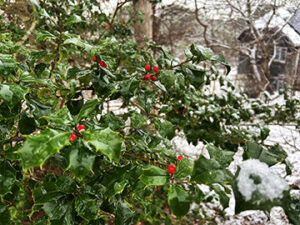Our Forest Future

It is evergreen, yet not coniferous. Its leaves are smooth, yet prickly. Its bark is smooth, and light in color, yet the tree is not an American beech.
In the winter, this tree beckons the woodland walker. Its glossy green leaves gleam in the winter woods. Amid the drab, gray stems of the oaks and hickories and viburnums, this tree stands out. The tree is American holly, Ilex opaca, and it is our native holly. From Chappaquiddick to Aquinnah, American holly grows in the wild across the entirety of Martha’s Vineyard. For the forests of our island, American holly is the tree of the future.
On a foggy Christmas Eve morning, I set out with my son, Huck, in search of festive boughs of holly. The day was a damp one. A steady drizzle fell in the woods. Drops of rain gathered on the lichen-crusted twigs of oaks, and gently dripped onto the forest floor below. A cold mist drifted past the bare, red twigs of the bristling huckleberry.
We ventured out to Roth Woodlands in Chilmark, as on this property – the headwaters of the Mill Brook – American holly grows in profusion. Here grow mature hollies, perhaps 30 feet tall, and stout pole-size trees, and a plethora of eager saplings, sprouting up everywhere across the forest floor. We sought boughs of the female trees, where the branches bore not just the prickly, green leaves, but also bright red berries. We were not disappointed. With two pairs of loppers, we snipped plenty of boughs, and enough to bedeck our table with holly arrangements.
Our American beech trees are likely doomed to a drawn-out death by defoliation due to the beech leaf disease. The beeches, we mourn.
Our pitch pines will manage with their new companion, the southern pine beetle, but most of the mature ones will likely die within the next decade. We will thin the pine forests to give the remaining pitch pines a fighting chance, and saw the felled ones into hardy lumber. The pines, we tend and we harvest.
But what of the hollies? The hollies, we celebrate. American holly appears poised to flourish in the growing space soon to be afforded it. It grows in wetlands and uplands. It grows in the shade beside the beech, and will take over when its neighboring beeches die. It grows in the shade of hickories and oaks in the picnic woods of Quansoo. Perhaps its prickly leaves make it unpalatable to browsing deer.
Some years ago, on a forestry field trip, I visited the sunken forest at the Fire Island National Seashore, off of Long Island. The sunken forest is a grove of American hollies. The hollies fill a depression behind the dunes, and a trail allows one to ramble beneath their evergreen canopy. The memory of this grove has remained with me for decades. I envision the same such groves of American hollies, and much grander groves of hollies of greater stature, emerging in the woodlands of our island.
In the lifetime of our grandchildren, our conserved lands shall grow splendid forests of American holly. They will be the pride of Martha’s Vineyard and a delight to future woodland walkers. In this new year, I offer a toast to American holly, the forest of our future.

